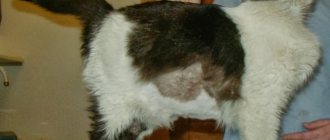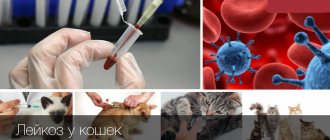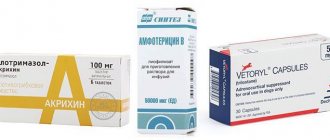Arthritis (from the Latin “arthritis”) is an inflammation of the joints, a disease belonging to a large group of rheumatic disorders that have similar symptoms. In monoarthritis, the inflammatory process is localized in one joint; if several joints are affected, we are talking about polyarthritis.
This disease is not common in cats and is considered age-related, although it can be caused by other reasons. Arthritis requires mandatory treatment: as a result of its development, bones can become deformed, articular cartilage and synovial membranes can become thinner, and in advanced cases, the animal can become disabled.
Causes of arthritis
According to veterinary orthopedic specialists, the following reasons lead to inflammation of the joints:
- Advanced age of the pet . The passing years lead to a decrease in the elasticity of connective tissue, deterioration of the trophism of the organ, which leads to arthritis in an elderly animal.
Osteoarthritis in aging cats primarily affects the shoulder and elbow joints. After 12 years, the disease occurs in 90% of individuals.
- Genetic predisposition . Some breeds that have appeared as a result of artificial selection recently have been susceptible to inflammatory processes of the musculoskeletal system.
Most often, fold-eared cats, such as the Scottish Fold, suffer from this disease. The defective gene is associated with a phenomenon called hip dysplasia. Congenital anomalies in the structure of connective cartilaginous tissue are also common in such breeds.
- Injuries . Falls from heights, collisions with vehicles, fights with relatives and the original feline enemies - dogs, are usually accompanied by bruises, dislocations, and sprains. Damage to the tissues of the musculoskeletal system as a result of trauma leads to inflammatory processes and the development of traumatic arthritis.
This category also includes birth trauma, which causes deformation of the hip joint and resulting inflammation.
- Obesity . Extra pounds on a furry pet puts additional stress on the joints, increases friction in the organ, and reduces the amount of intra-articular fluid, which provokes an inflammatory process.
- Autoimmune diseases are the most common cause of so-called rheumatoid arthritis in pets. The pathology is due to the fact that for some reason the cat’s body synthesizes substances that destroy its own cartilage tissue. The disease is generalized, affecting almost all joints.
- Acromegaly can lead to arthritis in domestic cats . The pathology is associated with increased synthesis of growth hormone, which leads to degenerative processes in cartilage tissue.
- Metabolic disorders . This category of causes causes the development of so-called metabolic arthritis. A deficiency of calcium, phosphorus, and an incorrect ratio of these elements causes disruption of the structure of cartilage and bone tissue, leading to the development of multiple inflammatory lesions of the joints.
A pathology such as heterochromatosis, in which iron accumulates in the elements of the musculoskeletal system, also contributes to the development of polyarthritis in domestic animals.
- Infectious processes in the body of various etiologies: viral, bacterial, fungal. Pathogenic microorganisms become the main factor in the development of the purulent form of the disease. The cause of polyarthritis is often viral influenza, calcivirus, and hepatitis virus in cats.
Veterinary specialists, based on many years of practice, believe that inflammation of the joints in furry pets can be provoked by an unbalanced diet, weakened immunity, increased physical activity, and exposure to cold.
We recommend reading about it. Why is the cat limping on his paw? You will learn about the possible causes of lameness, options for helping your pet at home and in a veterinary clinic. And here is more information about the treatment of dislocation in a cat.
How to use gelatin for joints: the best recipes
The difficulty of diagnosis lies in the “secrecy” of cats. When a person’s knee hurts, he talks about it; when the joint “torments” a cat, it adapts. The only way to identify the disease is to take a detailed history. Symptoms of arthritis are subtle and develop gradually:
- Behavioral changes: The animal does not allow joints to be touched, becomes irritated, and becomes aggressive when examined.
- Discontent and aggression in response to the attention of other animals or people, the cat prefers to spend a long time alone.
- The pet refuses to play, hunt, or walk.
- Decreased activity and mobility: Sleeping longer. The place to stay is available.
- The animal avoids jumping from heights and walking on stairs.
- Refusal to use a scratching post.
- After visiting the litter box, the cat does not bury feces.
- Reducing the time and “area” of licking, for example, the animal only washes its face. Perhaps licking only the “sore” area.
If you notice the above symptoms, it makes sense to take your cat to the vet. An experienced doctor, with a tactile examination, will understand whether the animal is experiencing joint pain. If you have experience in keeping animals and the cat trusts you, you can carry out the initial examination yourself:
- Calm the animal and slowly, with massaging movements, feel the hip, elbow, wrist and shoulder joints.
- Gently bend and straighten your cat's limbs.
- The main signs of a pain reaction: the cat has shown aggression, squints, pulls its ears back, is overly tense, the animal’s muscles twitch sharply or “takes in” its breath when flexing/extending the joint.
Write down any symptoms you notice and clearly communicate them to your doctor. If necessary, the animal will be prescribed an x-ray of the joints, a detailed blood and urine test, tests for worm infections, and hormonal tests. If no serious disorders are detected, treatment is carried out with the help of complex, anti-inflammatory, immunostimulating drugs, and the disease is “attributed” to age-related changes.
It is hardly possible to find at least one person who has not tried fruit, milk or chocolate jelly, jellied meat, and various jellied dishes. All these culinary masterpieces are prepared on the basis of gelatin. But few people know that this substance can be used not only in cooking, but also for the treatment of diseases of the musculoskeletal system.
Gelatin is most often used for joints with degenerative-dystrophic changes (arthrosis). Of course, traditional medicine does not recommend treating joints in this way, but at home such therapy sometimes even turns out to be very effective, as evidenced by positive reviews from patients with arthrosis.
Gelatin and its beneficial properties for joints
Gelatin is a protein substance that is obtained by denaturing collagen molecules from animal bones, tendons, cartilage and skin. The method for producing gelatin was invented by Jean Darcet, a French chemist, back in the eighteenth century.
It should be immediately clarified that in this article we are talking only about edible gelatin, and not about carpentry gelatin, which is used as glue.
Today, edible gelatin can be purchased at any grocery store, and there are even instant forms. This product is affordable. When in contact with moisture, dry gelatin powder swells and turns into a viscous transparent mass.
Why is gelatin good for joints? As already mentioned, it is based on collagen. Collagen fibers form the framework for intra-articular hyaline cartilage. With arthrosis changes, when articular cartilaginous structures are damaged, the use of gelatin can restore cartilage tissue. In this way, you can prevent osteoarthritis or stabilize a disease that has already begun.
It is necessary to note other positive aspects of using gelatin:
- if you take gelatin often, the condition of your hair improves;
- the gastric mucosa becomes resistant to negative manifestations if you drink gelatin tinctures regularly;
- memory becomes better;
- prevents platelet aggregation and blood clot formation if used continuously;
- slows down the aging process of the skin and musculoskeletal system (anatomical structures that most need collagen).
If you regularly use gelatin, then after 2-4 weeks you can notice positive results - joint pain decreases, joint mobility increases, muscle strength increases.
Gelatin medicinal drinks
Most folk recipes from gelatin involve preparing a kind of thick drink, which, as some people think, is not at all disgusting to drink, but, on the contrary, delicious. After all, sweeteners can be added to such tinctures for taste (sugar, honey, fruit syrup). The therapeutic effect will not be affected by this. Let's look at the most popular gelatin drinks for treating joints.
Symptoms in cats
Irreversible functional disorders in the joint begin with the destruction of cartilage and bone tissue. Degenerative processes lead to wear and tear of the elements of the musculoskeletal system, a decrease in intra-articular fluid and the development of inflammation.
The structure of a healthy joint and arthritis
At first, pathological changes do not cause pain to the animal, and the disease does not have pronounced symptoms. Stiffness of movement, severe pain, and changes in the general condition of the pet do not develop immediately. In this case, the owner may note the following clinical signs in a domestic cat:
- Decreased physical activity. The pet avoids jumping, reluctantly takes part in active games, and does not hunt mice and birds.
- Lethargy, apathy, fatigue. The cat spends most of its time sleeping or half asleep.
- After resting or sleeping, the animal has difficulty getting up and moving. Movements are constrained, gait is cautious. After some time, the gait becomes normal.
- The cat stops using the scratching post and avoids going up the stairs.
- Reduces grooming and is reluctant to lick. After visiting the litter box, he does not bury feces. This behavior is associated with joint pain.
- A previously friendly animal becomes aggressive when touched. The cat does not allow itself to be controlled, is nervous and worried.
- When you feel the joints, swelling, pain, and thickening are detected. In some cases, thinning of the limbs is observed.
- The bone joints are hot to the touch.
- The animal has an increase in body temperature, poor appetite or refusal to feed.
Many owners of sick animals note that with an inflammatory disease of the musculoskeletal system, the pet tries to avoid communication with household members and seeks solitude.
For information on the causes and symptoms of joint diseases in cats, watch this video:
Adjuvant therapy
If a sick cat suffers from obesity, he must be put on a diet (approved by a veterinarian, of course). This is especially important for older animals.
Important! There is no need to completely deprive your pet of food, as this will lead to exactly the opposite results.
Specially designed “joint” diets are recommended. Their components contain combinations of essential fatty acids (EFAs), which serve to reduce inflammation and glycosaminoglycans (such as glucosamine and chondroitin). The latter are part of cartilage. Supplements of this type are completely safe for the animal. The problem is that veterinary practitioners are very leery of oral supplements.
In any case, they are not used as the main therapy: diet is used only as an additional therapeutic technique. In general, the use of agents injected directly into the joint is recommended.
I would like to note that in the most severe and advanced cases of joint disease in cats, they are treated using synthetic prostheses. If the joint has undergone degenerative changes, only implants can restore mobility and maintain a more or less high quality of life for the animal.
Source vashipitomcy.ru
Diagnosis of the disease
Uncharacteristic symptoms and similarity with numerous other pathologies of the musculoskeletal system make early diagnosis of the disease difficult. An experienced veterinarian will pay attention first of all to the unkempt coat and plantigrade position of the hind limbs.
Classification of arthritis
An orthopedic examination involves a specialist observing the animal in motion. However, in a clinical setting it is not always possible to obtain a reliable picture due to the inappropriate behavior of a furry pet in an unfamiliar environment. Video recording methods that can be used by owners of a sick animal come to the rescue.
After the gait has been studied, the veterinarian begins to palpate the joints to detect swelling, pain, and changes in the anatomical configuration.
Special research methods, for example, radiography, can help in identifying inflammatory processes. On it, an experienced orthopedic doctor will detect anomalies indicating degenerative-dystrophic changes in the organ, osteophytosis (bone growths), swelling of soft tissues due to inflammation.
X-ray (lateral view) of the elbow joint of a cat with osteoarthritis
An informative method in the diagnosis of arthritis is the study of synovial fluid to detect pathogenic microflora and select an effective antibacterial agent.
As additional diagnostic methods, high-tech examination of the condition of joints using magnetic resonance and computed tomography can be used.
Clinical and biochemical tests of blood and urine are prescribed by a veterinary specialist, as a rule, for the purpose of differentiated diagnosis and identification of concomitant pathologies.
Care
A sick animal needs privacy. The optimal solution is to arrange a cat house with soft bedding. Do not allow your pet to remain on a concrete or tiled floor or in drafts for a long time. Use a tray with one of the sides low. The pet's fur is regularly combed and its nails trimmed.
cat house
Treatment methods
Polyarthritis in domestic cats is a chronic process with severe pain that has to be managed over a long period of time. In this regard, orthopedic veterinarians try to choose not only effective medications, but also drugs that have minimal toxic effects on the animal’s body.
On the list of medications prescribed to domestic cats for arthritis, non-steroidal anti-inflammatory drugs take first place. Prostaglandins block the breakdown of arachidonic acid, which is involved in the inflammatory process.
For long-term treatment of pathologies of the musculoskeletal system, drugs such as Meloxicam and Piroxicam have found wide use in veterinary practice. Both nonsteroidal anti-inflammatory drugs are used once daily. The dose and duration of the course are determined by the attending veterinarian.
NSAIDs in the treatment of arthritis
When the process worsens, painkillers such as Buprenorphine, Amantadine, Fentanyl, Tramadol, Gabapentin can be used to relieve pain. The difficulty with using opioid medications is that many pain medications are controlled drugs.
Long-term use of glucocorticosteroids in the form of Prednisolone and Dexamethasone does not bring a therapeutic effect and is associated with a number of undesirable side effects.
In addition to drug treatment, modern veterinary medicine recommends that owners of sick animals pay attention to physiotherapy: reflexology (acupuncture), manual massage, electrical myostimulation, laser use, hydrotherapy (swimming in the pool).
Prevention measures
In the prevention of the disease, constant monitoring of the condition of the joints in cats is important. It is equally important to maintain a healthy lifestyle, which will allow the cat to maintain good physical shape:
- Regular orthopedic examinations. They are especially important when the cat reaches a respectable age.
- Weight control. It is carried out with a well-chosen diet that provides adequate nutrition while maintaining a normal weight.
- Regular addition of vitamin and mineral complexes to food containing medicinal additives that support the health of articular cartilage.
- No drafts in the apartment.
- Lack of excessive physical activity that injures joints.
If the cat is receiving treatment, it is necessary to periodically bring it for a medical examination to monitor the dynamics. Particular care must be taken to monitor the condition of animals receiving non-steroidal anti-inflammatory drugs. The prognosis of the disease is ambiguous. Treatment results may vary. This depends on the age of the cat, on what stage of the disease therapy was started, and whether there are severe concomitant diseases.
Care, maintenance and nutrition of a sick animal
The owner can alleviate the condition of a cat with arthritis not only by using medications prescribed by a veterinarian, but also by following certain rules for care and feeding.
First of all, you need to take care of the safe living of your pet indoors. If your cat likes to sleep in an elevated place, on a windowsill, or a closet shelf, you should equip this place with a warm lounger and take care of a safe descent. For this purpose, you need to install a chair or ladder so that the animal avoids jumping.
The best solution would be to purchase or make your own cozy house with a warm and soft lounger. Such a sleeping place will allow a sick pet to rest in a safe, dark place. It is necessary to completely exclude the cat from being on cold concrete floors, tiles, in drafts and in damp rooms.
Doors in the house should be secured in the open position. This will make it easier for the cat to walk. You also need to pay attention to the shape of the cat litter box. The tray on one side should have a lower side so that it is not difficult for the cat to enter it.
The owner of a sick pet should pay great attention to hygiene procedures. The animal needs regular help with grooming and trimming its nails.
The complex of measures for caring for a cat suffering from arthritis includes proper feeding. First of all, the owner must take measures to prevent obesity. If the animal is already overweight, the attending physician should recommend a diet to reduce it.
In order to reduce inflammatory processes in the musculoskeletal system, various biological additives are used in veterinary practice, for example, omega-3 fatty acids, glucosamine, chondroitin . These substances are involved in the synthesis of cartilage tissue, which helps improve the condition of the joints.
Some cat food manufacturers produce special medicinal series that include substances that are beneficial for an arthritic cat, for example, Hill's PD J/D, Pro Plan Veterinary Diets Feline. The food contains a number of biologically active substances, for example, eicosapentaenoic acid, omega-3 fatty acids, glucosamine and chondroitin, which reduce pain, degenerative and inflammatory processes in cartilage tissue.
A cat with arthritis is strictly contraindicated from table food, fatty, canned, salty and sweet foods. Preference should be given to lean meat, raw and boiled vegetables, water-based cereals, and dairy products.
We recommend reading about cellulitis in cats. You will learn about the causes of phlegmon development, stages of inflammation, diagnosis and treatment. And here is more information about immunodeficiency in cats.
Arthritis in domestic cats is a common chronic disease. The disease has no characteristic symptoms and is difficult to diagnose in the early stages of the process. Treatment is complex and includes not only long-term use of anti-inflammatory drugs, but also physiotherapy. The effectiveness of therapy largely depends on proper care and feeding of the sick pet.
How can you help a pet with arthritis?
Your pet may remain in pain for a long time during treatment, so veterinarians can recommend many great natural treatments and remedies for this condition that can reduce or eliminate the need for pain medications, many of which are highly toxic to cats.
Some of the treatments include:
- High quality omega-3 supplement (such as krill oil)
- Massage to reduce inflammation and pain in damaged tissues
- Injections to stimulate joint fluid
- Glucosamine sulfate, eggshell membrane
- Ubiquinol and turmeric
- Supergreens such as spirulina and astaxanthin
- Natural anti-inflammatory formulas (herbs, proteolytic enzymes)
- Maintaining a lean, healthy weight. An obese cat with arthritis may have noticeable improvement in symptoms after small weight losses.
- Muscles support your pet's figure, so maintaining muscle tone will also slow down weakening of the joints. Older cats need daily exercise to slow atrophy and maintain muscle tone.
- Balanced nutrition suitable for a specific breed and complexion.
cat diseases
Useful video
To learn how to treat arthritis, watch this video:
Similar articles
- The cat is limping on a paw (back or front), the paw is swollen...
With dysplasia in cats, the owner can observe that the cat is limping on its hind paw. ... Arthritis requires complex treatment, the basis of which is ... Read more - Vitamin deficiency in a cat: symptoms, how it manifests itself...
How does vitamin deficiency manifest itself in a cat? The pathology most often develops in... problems with the musculoskeletal system (arthritis), urolithiasis. Read more
- Perianal inflammation in a cat: symptoms...
Complex paraanal inflammation in a cat is a dangerous pathology. Not every owner knows... Read more
- Dislocation of a cat's hip joint, anterior or...
For example, when a cat has a bruise or injury to the occipital bone, its jaw dislocates. ... Joint diseases - arthritis, arthrosis - often lead to impairment... Read more
- Cellulitis in cats: why it appeared on the paw and how...
How does phlegmon manifest in cats, how dangerous it is and how to treat it. ... for example, dermatitis, purulent arthritis, various abscesses, pulpitis, etc. In this case… Read more
How to use this drug
The drug can be used for 2 years after its production, after which it becomes ineffective.
The medicine is used, as stated in the instructions for use, for acute and chronic diseases associated with the musculoskeletal system. This includes diseases such as:
- arthritis and arthrosis;
- osteoporosis and joint dysplasia;
- osteoarthritis and osteoarthritis, etc.
You can use the medicine if there is particularly increased stress on the joints or after surgical interventions performed on the musculoskeletal system, but only as prescribed by a doctor.
If any component causes a negative reaction in the body, it means there is an individual intolerance, and this fact is a contraindication for use.
The stoparthritis instructions also warn that during treatment it is advisable not to drink alcoholic beverages or smoke.
Stop Arthritis Forte 90 capsules have the property of quickly acting on painful joints, exerting a beneficial effect thanks to a well-chosen, balanced composition.
The sulfates of glucosamine and chondroitin contained in the drug are substances that form the structure of articular cartilage. The absence of these components is the cause of many diseases of the musculoskeletal system.
With the help of Stop Arthritis Super, you can restore damaged joint capsule, joint surface, and improve the process of joint fluid production. Recommended as a biological supplement to the main diet.











